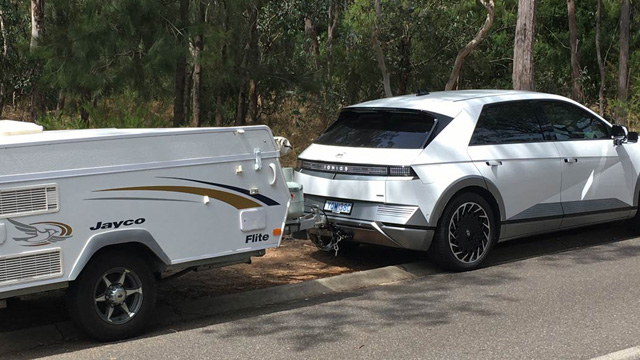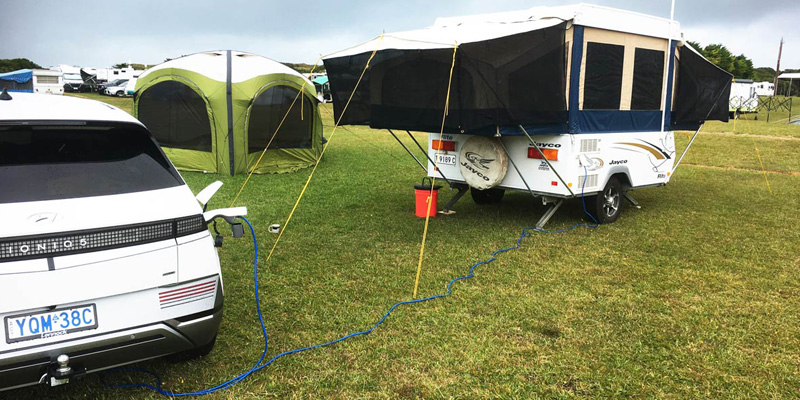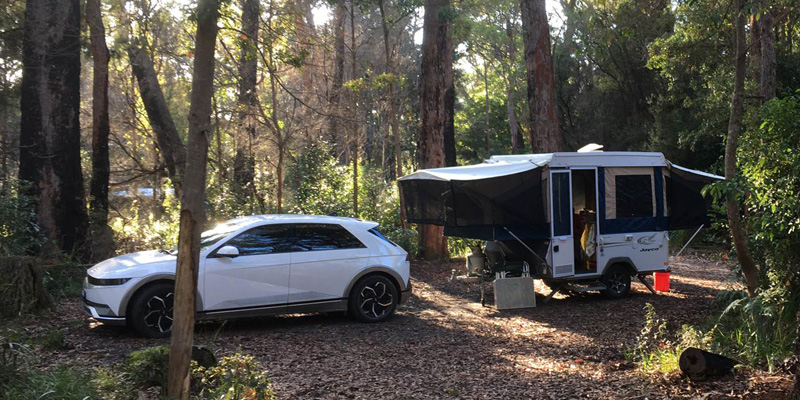

This website uses cookies to improve the user experience. We use cookies in accordance with our NRMA Group Cookie Policy.
This website uses cookies to improve the user experience. We use cookies in accordance with our NRMA Group Cookie Policy.


This rating is based on an NRMA road tester's evaluation of the vehicle against similar competitors and is provided as a guide only.
Peter's first EV was a home converted 1992 Daihatsu Charade, which he owned from 2009-2018.
He has also owned a 2012 Mitsubishi i-MiEV from 2013 to 2019, a 2014 Holden Volt from 2018 to 2019, and a 2019 Hyundai Kona from 2019 to 2023.
He has driven 15,000km in the IONIQ 5.
We had been happy with our previous 2019 Hyundai Kona, but it was not officially rated to tow.
We wanted a manufacturer’s tow rating so we could use our Jayco wind-up camper trailer with official sanction.
Switching to the IONIQ 5 was the best fit to retain what we liked about the Kona while gaining a tow rating and not ending up with a much bigger car than we needed.
We also considered a Tesla Model Y, a Kia EV6 and an EV from either Polestar or Volvo.
Charging has been fine, with most charging done at home.
We have done some highway DC charging on longer trips out of town, some AC charging at destinations such as caravan parks, motels, and relatives’ homes.

Yes. It is amazingly quick on the fastest DC chargers.
The only disappointment is that, like other 800V architecture eGMP vehicles, it only gets 42kW from a Tesla V3 supercharger.
It charges faster from the older, nominally slower, V2 Tesla chargers. I suspect the V3 Superchargers are not 100% compliant with the CCS standards.
When I got only 42kW from a V3 Tesla charger, I then drove around the corner to an older 50kW Tritium charger and got 50kW, so there is nothing wrong with the car’s ability to do its on-board voltage step up from 400V to the battery’s approx. 700V
No, but we have had the car less than a year.
I don’t expect to see a substantial drop for many years, especially as we avoid both charging above 80% and deep discharge for day-to-day driving.
We only charge to 100% ahead of a long drive, which is often enough for cell balancing and recalibrating the battery gauge. An NMC (nickel-manganese-cobalt) battery mostly operated in the upper middle range of charge curve should not show substantial loss of capacity until it has a few thousand charge cycles.
With over 400km range, a 1000 charge cycles would be 400,000km, which would be over 20 years for us.
Even then, even if it has lost (say) 25% of its capacity, it will have over 300km of range, which will be sufficient for many people’s needs.
In urban driving, its range is probably close to 500km, not that we need that around town.
On the highway, only a bit over 400km - you see the effect of its large frontal area with efficiency dropping over 100kph.
It is a bit of a hog compared to our previous, smaller Kona, which would give the same range from a 17% smaller battery.
Towing our 2010 Jayco Flite camper trailer, and dropping our maximum speed to 90-100kph, range reduces by about a third to about 290km.
The car is very comfortable and has more than ample performance.
It tows our camper trailer up steep hills without apparent effort, including, on one occasion, a steep, wet, unsealed national park track without a hint of slipping.
However, its 160mm ground clearance is really only just sufficient for comfort on an occasional dirt track.

Yes, happy with the styling. Interesting without being aggressive or glitzy like many other cars.
However, we thought the light interior was impractical and a dark interior was only an option with a black or white exterior and we also thought a black exterior is impractical.
So, white became the only acceptable colour option.
Yes, aside from its lack of a rear window wiper.
The 15A Vehicle to Load feature is nifty. It replicates a standard caravan park powered site. So, we can take our trailer camping off-grid and still use mains powered accessories without needing to have a large battery and inverter installed in the trailer.
It has also let me use corded power tools away from a power point. It has a very efficient use of internal space.
The ability to slide the whole back seat forwards could be useful for families with young children who don’t need much rear leg room but have lots of luggage
We paid $83,000 in total, of which about $1500 was an extra charge cable and optional towbar. So, $81,500 for just the car.
It has represented good value - at the time we bought it there were only three variants. You could only get AWD and some comfort features we wanted if you also got the more sporty, less efficient wider tyres on 20” wheels.
There are now more permutations offered to choose from. I swapped our 20” wheels for the more efficient 19” wheels from another HI5 owner who had them as his only option with a RWD model.
There have been no issues maintaining it but I would not expect any in a car that is not yet a year old. Running costs are low, as I would expect for an electric car.